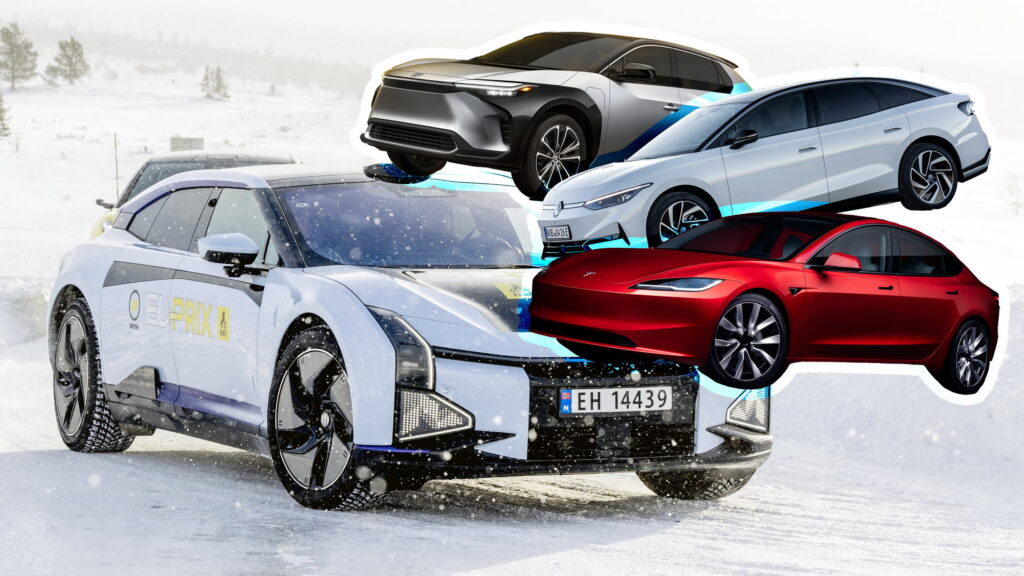It’s a well-known fact that colder temperatures can reduce the driving range of electric vehicles. However, a recent test in Norway revealed a winter efficiency champion: China’s Human Horizons HiPhi Z. Not only did it minimize winter weather range losses to just 5.9%, but it also outperformed all competitors in actual winter range.
The Human Horizons HiPhi Z joined a lineup of 23 electric vehicles for an extensive driving test conducted by the Norwegian Automobile Federation (NAF) and the local automotive outlet, Motor magazine. This challenging winter range assessment unfolded at the end of January, with temperatures oscillating between a frosty -2 to -10 degrees Celsius or a 28.4 to 14 degrees Fahrenheit.
Despite not having the longest WLTP-rated range in the group, the Chinese EV was so resistant to the cold that it ended up going farthest of all during the evaluation. In the end, the HiPhi Z managed to drive 324 miles (522 km) on a single charge in the test. This meant that its range degraded by less than 6 percent in cold temperatures, and made it the only EV in the group to lose less than 10 percent of its WLTP-rated driving capability.
Winter Driving Range Results (Miles)
The other EVs in the test exhibited varying degrees of winter range reduction. For instance, the BMW i5 experienced a 12.2 percent decrease, declining from 505 km (314 miles) to 443.6 km (276 miles), with similar results for the Kia EV9 and Lotus Eletre. In contrast, the Ford F-150 Lightning’s range witnessed a more substantial drop of 21.3 percent, plummeting from 429 km (267 miles) to 337.5 km (209 miles).
Read: Human Horizons Is Bringing Its HiPhi Brand To Europe
Among the weakest performers were Tesla’s facelifted Model 3 ‘Highland’ with a 29.9 percent reduction (from 629 km down to 441 km, or 390 miles down to 274 miles), Polestar’s 2 Long Range with a 30 percent decrease (from 614 km to 430 km, or 381.5 miles to 267.1 miles), followed closely by Volvo’s C40 Recharge, which saw a 30.9 percent reduction from 572 km to 395 km (355 miles to 245.4 miles).
The biggest losses were recorded by Toyota’s bZ4X that experienced a substantial 31.8 percent range reduction (from 460 km to 313.5 km, or 285.8 miles to 194.7 miles), and Volkswagen’s ID.7, which faced a 31.9 percent decrease in range from 608 km to 414 km (377.7 miles to 257.2 miles).
What’s Their Secret?
The Shanghai-based carmaker attributes the HiPhi Z’s remarkable tolerance for the cold to its “Efficient Thermal Management System.” Developed in-house, the system combines a heat pump HVAC with an intelligent E-Powertrain thermal management system to keep the battery within its optimal operating window for as long as possible.
According to test driver Simen Zimmermann, the HiPhi Z managed to keep the battery warm while also keeping the cabin temperature comfortable, both of which are important on chilly drives through the Norwegian wilderness.
“Tireless innovation and unique technology development is at the heart of our company, and our team is not only proud of this recognition but also the exceptional comfort the HiPhi Z demonstrated,” said Mark Stanton, co-founder and chief technical officer at Human Horizons.
Human Horizons bills itself as a manufacturer of premium electric vehicles, and it made its first foray into the European market last year. It operates HiPhi Hubs in Munich, Germany, and Oslo, Norway. In addition to the HiPhi Z, it also makes the HiPhi X and the HiPhi Y crossovers.








